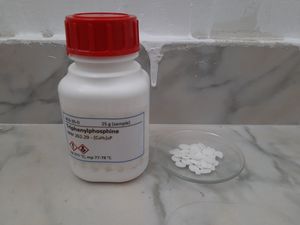Difference between revisions of "Triphenylphosphine"
| Line 7: | Line 7: | ||
| OtherNames = TPP | | OtherNames = TPP | ||
<!-- Images --> | <!-- Images --> | ||
| − | | ImageFile = | + | | ImageFile = Triphenylphosphine sample bottle.jpg |
| − | | ImageSize = | + | | ImageSize = 300 |
| ImageAlt = | | ImageAlt = | ||
| ImageName = | | ImageName = | ||
| + | | ImageCaption = Triphenylphosphine sample and original bottle. | ||
| ImageFile1 = | | ImageFile1 = | ||
| ImageSize1 = | | ImageSize1 = | ||
| Line 121: | Line 122: | ||
===Physical=== | ===Physical=== | ||
| − | Triphenylphosphine is a white solid, | + | Triphenylphosphine is a white solid, soluble in organic solvents. |
==Availability== | ==Availability== | ||
Latest revision as of 14:18, 6 October 2019
 Triphenylphosphine sample and original bottle.
| |
| Names | |
|---|---|
| IUPAC name
Triphenylphosphane
| |
| Other names
TPP
| |
| Properties | |
| C18H15P P(C6H5)3 PPh3 Ph3P | |
| Molar mass | 262.292 g/mol |
| Appearance | White solid |
| Odor | Nearly odorless |
| Density | 1.194 g/cm3 (at 20 °C) |
| Melting point | 80 °C (176 °F; 353 K) |
| Boiling point | 377 °C (711 °F; 650 K) |
| 0.0017 g/100 ml (at 22 °C) | |
| Solubility | Soluble in glacial acetic acid, benzene, CCl4, chloroform, diethyl ether, THF Slightly soluble in alcohols |
| Vapor pressure | 1.1·10-4 mmHg |
| Acidity (pKa) | 7.64 (pKa of conjugate acid in acetonitrile) |
| Hazards | |
| Safety data sheet | Sigma-Aldrich |
| Flash point | 180 °C (356 °F; 453 K) |
| Lethal dose or concentration (LD, LC): | |
| LD50 (Median dose)
|
700 mg/kg (rat, oral) |
| Related compounds | |
| Related compounds
|
Phosphine |
| Except where otherwise noted, data are given for materials in their standard state (at 25 °C [77 °F], 100 kPa). | |
| Infobox references | |
Triphenylphosphine (IUPAC name: triphenylphosphane) is a common organophosphorus compound with the formula P(C6H5)3 - often abbreviated to PPh3 or Ph3P.
Contents
Properties
Chemical
Triphenylphosphine is a weak base, but does form stable salts with strong acids such as HCl and HBr.
Triphenylphosphine undergoes slow oxidation by air to give triphenylphosphine oxide, Ph3PO:
- 2 PPh3 + O2 → 2 Ph3PO
Triphenylphosphine abstracts sulfur from polysulfide compounds, episulfides, and elemental sulfur, forming triphenylphosphine sulfide, Ph3PS. Simple organosulfur compounds such as thiols and thioethers are unreactive, however.
Physical
Triphenylphosphine is a white solid, soluble in organic solvents.
Availability
Triphenylphosphine is sold by lab suppliers.
Preparation
Can be made by reacting phosphorus trichloride with phenylmagnesium bromide or phenyllithium.
Projects
- Make triphenylphosphine oxide
- Make PPh3 complexes ([Co(PPh3)2]Cl2 e.g.)
Handling
Safety
Triphenylphosphine is irritant.
Storage
In closed plastic or glass bottles, away from oxidizers.
Disposal
Controlled oxidation/incineration will suffice.